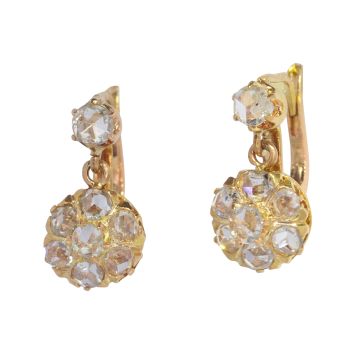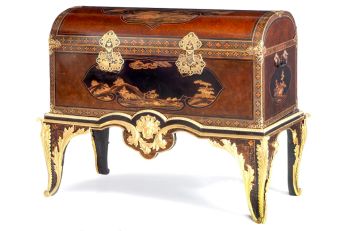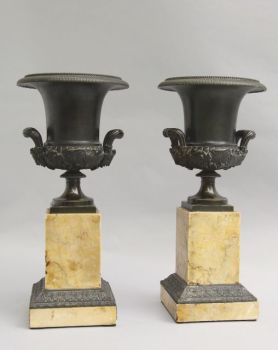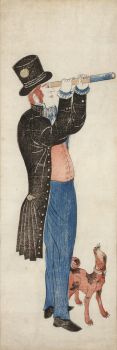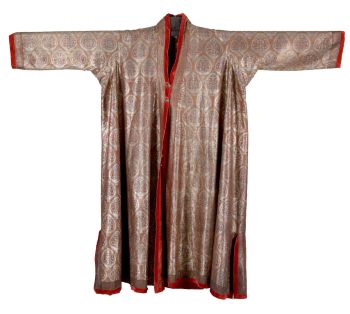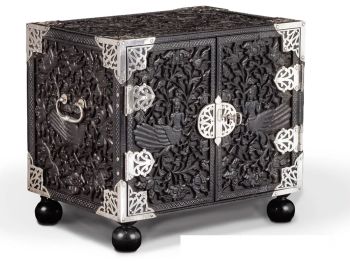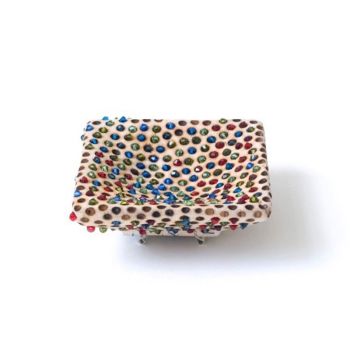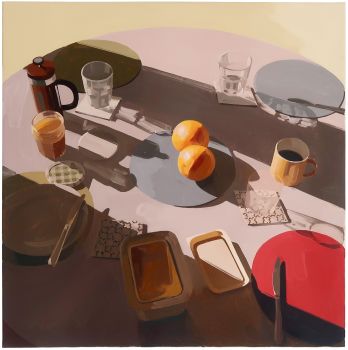A very rare Indian Armorial Palempore Chintz for the Dutch Market 1750
Onbekende Kunstenaar
TextielKatoen
333 ⨯ 225 cm
Prijs op aanvraag
Zebregs & Röell - Fine Art - Antiques
- Over kunstwerkCoromandel coast, probably Sadraspatnam (Sadras), first half 18th century
Cotton, mordant- and resist-dyed, painted, 333 x 225 cm
“Palempore” refers to large chintzes laid on a bed or hung behind it. The present very large palempore in the centre shows a coat of arms with a redish salient deer in front of a green tree on the ground, the crest with a deer issuant. The mantling shows scrolling leaves and European style scrollwork in red and green, within a circle of flowers. In the corners of the white field four vases with large flower bouquets. The borders are decorated with undulating vines with flowers and leaves issuing from large flowers and leaves in each corner and in the middle of the long sides.
The coat of arms probably belongs to Jacob Hartogh (Leiden, 30 October 1701 - Delft after 1756), a cloth manufacturer in Leiden. His father, Hendrik Hartogh, a cloth-shearer, emigrated from Bremen to Leiden at the end of the 17th century. He married Jannetje Pieters in 1701 and the couple had two sons, Jacob and Jan. Jacob, from 1740 till 1756, owned a cloth factory at the Turfmarkt in Leiden. In 1756 he sold the factory and settled in Delft. Jacob married twice, first to Katharina Paré (1697-?) in 1721, and secondly some time before 1735 to Marianne Petit (1708-?). His son from the first marriage, Michiel Hartogh, also became a cloth manufacturer in Leiden and his descendants held public posts in Delft and Rotterdam during the second half of the 18th century.
Jacob possibly ordered the palempore somewhere shortly before 1735. Jacob presumably also ordered an armorial chine de commande tea set, dated between 1730 and 1735, of which only some cups and saucers survive. The coat of arms on the tea set consists of a tree on the ground with a yellow tripping deer in front, the crest with a yellow deer issuant, and the mantling with polychrome scrolling leaves (Dr. Jochem Kroes, Chinese Armorial Porcelain for the Dutch Market, Waanders Publishers, Zwolle 2007, pg. 168).
Several other similar armorial chintzes all bear the arms of Frisian and Groninger families; Goslinga (Rijksmuseum, inv. BK-1980-795), Burmania (Rijksmuseum, inv. BK-1980-98), Alberda-Horenken-van Berum, Rengers van Welderen, and Douma van Langweer (Ebeltje Hartkamp-Jonxis, Sitsen uit India Indian Chintzes, Rijksmuseum Amsterdam 1994). Ebeltje Hartkamp-Jonxis dates these armorial chintzes to a short period between 1725 and 1730. The present palempore appears to be the only one of this design, probably ordered by a family from the province of Holland. Armorial palempores with different designs are known from Holland and Zeeland. - Over kunstenaar
Het kan voorkomen dat een kunstenaar of maker onbekend is.
Voor sommige werken is het niet te bepalen door wie het gemaakt is of dat het is gemaakt door (een groep) ambachtslieden. Voorbeelden zijn beelden uit de Oudheid, meubels, spiegels of handtekeningen die vaak niet duidelijk of leesbaar zijn. Maar ook sommige werken zijn helemaal niet gesigneerd.
Ook kunt u de volgende beschrijving vinden:
•"Toegeschreven aan …." waarschijnlijk een werk van de kunstenaar maar niet zeker of gedeeltelijk
•“Atelier van ….” of werkplaats van” een werk uitgevoerd in het atelier of atelier van de kunstenaar, eventueel onder zijn toezicht
•“Cirkel van ….” een werk uit de periode van de kunstenaar die zijn invloed laat zien, nauw verbonden met de kunstenaar maar niet noodzakelijkerwijs zijn leerling
•“Stijl van ….” of “Volger van ….” een werk uitgevoerd in de stijl van de kunstenaar, maar niet noodzakelijk door een leerling; kan eigentijds of bijna eigentijds zijn
•“Wijze van ….” een werk in de stijl van de kunstenaar maar van latere datum
•"Na …." een kopie (van welke datum dan ook) van een werk van de kunstenaar
•“Getekend…”, “Gedateerd….” of “Ingeschreven” dan is het werk gesigneerd/ gedateerd/ ingeschreven door de kunstenaar. De toevoeging van een vraagteken duidt op een element van twijfel
•"Met handtekening ...", "Met datum ...", "Met opschrift..." of “Draagt signatuur/datum/opschrift” dan is de handtekening/datum/opschrift toegevoegd door iemand anders dan de kunstenaar
Bent u geïnteresseerd om dit kunstwerk te kopen?
Artwork details
Related artworks
Unbekannter Künstler
Antike russische Holzikone: Erzengel Gabrielearly 17th
Preis auf AnfrageKunsthandel H.W.C. Dullaert Icons
1 - 4 / 12Unbekannter Künstler
WICHTIGE UND SELTENE GROSSE INDISCHE 'COMPANY STYLE'-MALEREI AUF Elfenbein, die eine Parade darstell1850 - 1900
Preis auf AnfrageZebregs & Röell - Fine Art - Antiques
 Kuratiert von
Kuratiert vonDanny Bree
Unbekannter Künstler
Japanese transition-style lacquer coffer 1640 - 1650
Preis auf AnfrageZebregs & Röell - Fine Art - Antiques
Paulus Franciscus Kromjong
Blumen vor Arearea Aka (Freude) von Gauguin '20th century
Preis auf AnfrageZebregs & Röell - Fine Art - Antiques
1 - 4 / 24Unbekannter Künstler
A Dutch colonial Indonesian betel box with gold mounts1750 - 1800
Preis auf AnfrageZebregs & Röell - Fine Art - Antiques
1 - 4 / 24Unbekannter Künstler
Holländer in Miniatur18th century
Preis auf AnfrageZebregs & Röell - Fine Art - Antiques
Shiba Kokan
Gemälde eines Fantasy-Holländersearly 19th
Preis auf AnfrageZebregs & Röell - Fine Art - Antiques
Unbekannter Künstler
Holländer in Miniatur (Netsuke)1700 - 1900
Preis auf AnfrageZebregs & Röell - Fine Art - Antiques
Unbekannter Künstler
A large Japanese Imari porcelain 'VOC Groningen' dish1800 - 1925
Preis auf AnfrageZebregs & Röell - Fine Art - Antiques
1 - 4 / 24- 1 - 4 / 24
Unbekannter Künstler
A large Japanese Imari porcelain 'VOC Groningen' dish1800 - 1925
Preis auf AnfrageZebregs & Röell - Fine Art - Antiques
Engelbert Kaempfer
ENGELBERT KAEMPFER BOOK1651 - 1716
Preis auf AnfrageZebregs & Röell - Fine Art - Antiques
1 - 4 / 12













